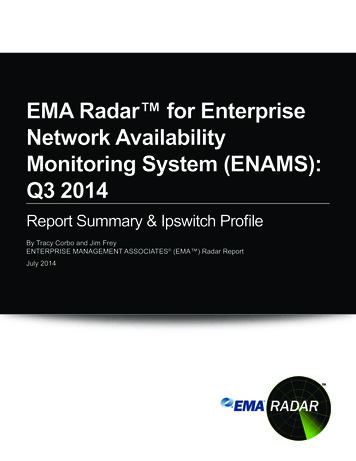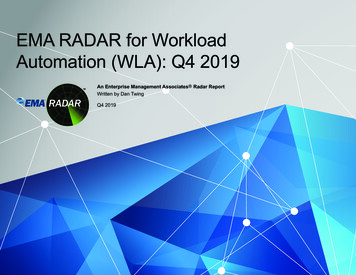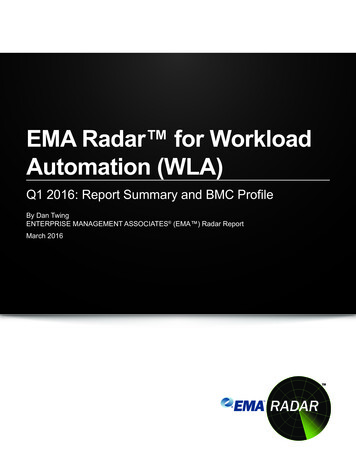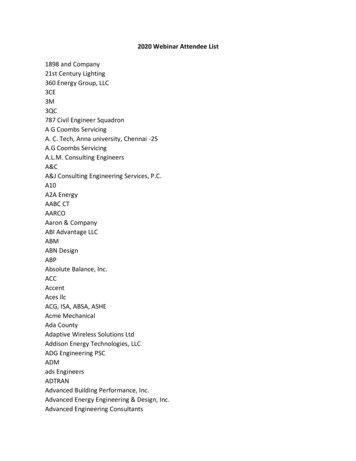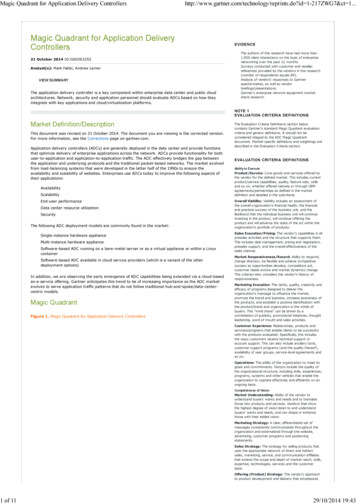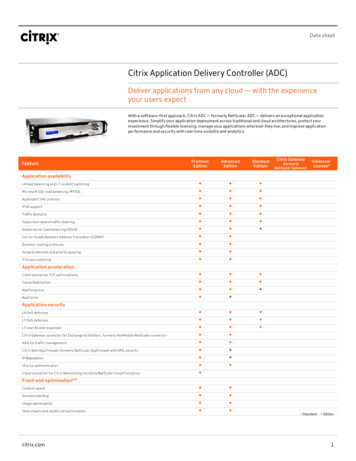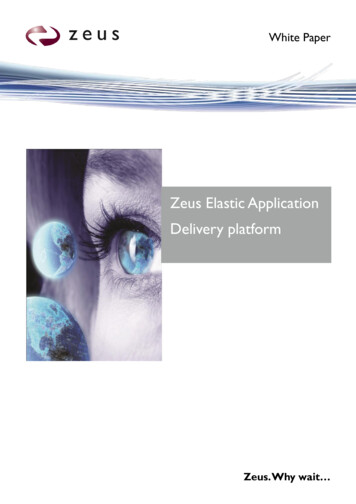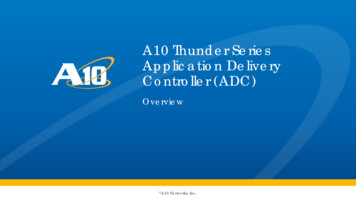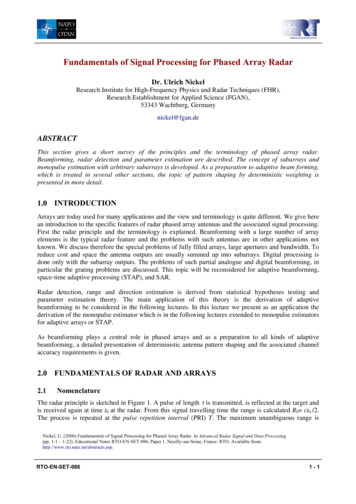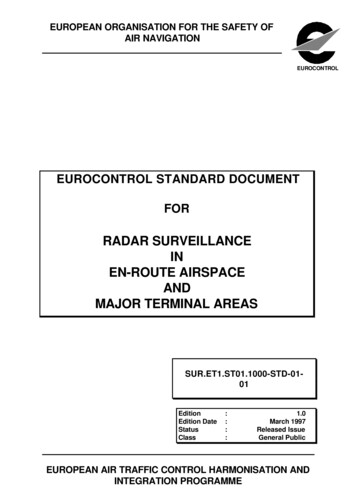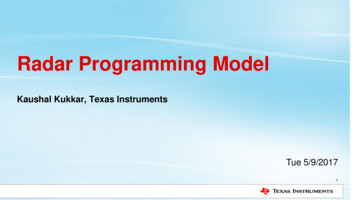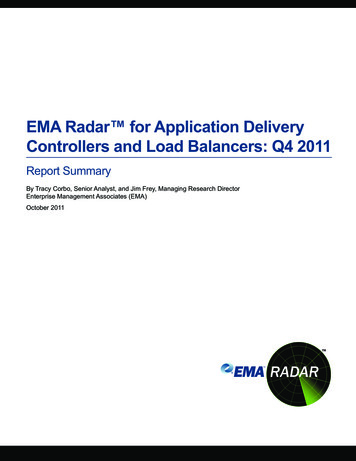
Transcription
EMA Radar for Application DeliveryControllers and Load Balancers: Q4 2011Report SummaryBy Tracy Corbo, Senior Analyst, and Jim Frey, Managing Research DirectorEnterprise Management Associates (EMA)October 2011
EMA Radar for Application Delivery Controllersand Load Balancers: Q4 2011 (Report Summary)Table of ContentsExecutive Summary.1Introduction and Methodology.1Improving Web Application Performance.2The Market and the Players.3The “V” Factor.3Focus of This Research.4Criteria.5Deployment and Administration.5Cost Advantage.6Architecture & Integration.6Functionality.7Vendor Strength.7EMA Radar Map for ADC/LB .8General Findings.9Distribution of Results. 11Value Leaders. 11Strong Value. 12Specific Value. 14Awards. 14Best Virtualization Approach: Zeus/Riverbed. 14Best Cloud Integration Approach: Citrix Systems. 14Customer Kudos: A10 Networks. 14Appendix A: EMA Radar Report Methodology. 15I 2011 Enterprise Management Associates, Inc. All Rights Reserved.
EMA Radar for Application Delivery Controllersand Load Balancers: Q4 2011 (Report Summary)Executive SummaryThe first generation ofLong before VMware made the term “virtualization” a common,network-based load balanceralmost ubiquitous term, early Load Balancers (LBs) were busysolutions were applicationabstracting away client requests from the physical server, creating aneutral – their primaryset of “virtualized Web services.” Web server load balancing evolvedfunction was to ensureas a way to ensure that inbound requests over IP-based networks didnot overwhelm the backend servers hosting Web sites and Web-basedthat traffic reached its finalapplications. The first generation of network-based load balancerdestination and that thesolutions were application neutral – their primary function was totraffic was evenly distributedensure that traffic reached its final destination and that the trafficacross multiple servers.was evenly distributed across multiple servers. A Web page requestcomes in-bound from an external client and instead of that requestgoing directly to the Web server; the load balancer receives and redirects the request to the mostappropriate server based on whichever load balancing algorithm is being implemented. The Web serverthen returns the information to the load balancer, which then sends it back to the requesting client.An added benefit to implementing a load balancer is that it cuts down on the time it takes to servicea request, thereby improving Web server response time. An Application Delivery Controller (ADC)is for the most part considered the next generation load balancer. Load balancing remains a corecomponent of today’s ADCs, but their functionality has expanded to include other features such asapplication acceleration, compression, caching, SSL offload, and application layer security, to name afew. In some cases, vendors continue to offer load balancers as a separate product for customers whojust want the core functionality and make the additional features available in an a la carte fashion, eitheras separate appliances or as add-on modules. For the purpose of this report the collective technologyspanning this spectrum of evolved features will be referred to as ADC/LB.In this ENTERPRISE MANAGEMENT ASSOCIATES (EMA ) Radar Report, 12 currentproviders of ADC/LB solutions are reviewed and compared according to a broad range of measuresregarding both product strength and overall cost efficiency.Introduction and MethodologyIn the development of this EMA Radar Report, EMA engaged 12 providers of ADC/LB solutionsin a detailed analysis of the scope and capabilities of their offerings. The solution providers representa mix of vendors, ranging from small, privately held, pure-play vendors to very large IT technologyproviders. ADC/LB solutions were traditionally sold as hardware appliances, but have since expandedto other form factors such as virtual machines. This EMA Radar Report covers ADC/LB solutionsfrom the following vendors: A10 Networks Citrix Systems ActivNetworks Coyote Point Systems Array Networks F5 Networks Barracuda Networks KEMP Technologies Brocade Communications Systems Radware Cisco Systems Riverbed Technology (Zeus)1 2011 Enterprise Management Associates, Inc. All Rights Reserved.
EMA Radar for Application Delivery Controllersand Load Balancers: Q4 2011 (Report Summary)In order to participate in the study, a vendor must have a product that supports the core load balancingfeatures for TCP/IP based networks. Full-blown ADC/LB solutions support additional featuressuch as complex server health monitoring, performance improvement, and security. An extensivequestionnaire was developed and presented to solution providers for their input, covering detailsregarding: architecture, integration, functionality, deployment, administration, cost, and vendor strength.EMA supplemented responses with dialog, product demonstrations and reviews to ensure that eachsolution was represented fully, honestly and fairly. EMA also interviewed end-user customers of thesolutions being reviewed as well as channel partners – in some cases several per solution provider – inorder to validate vendor claims. Finally, and importantly, EMA leveraged ongoing industry dialogs andextensive existing knowledge of the ADC/LB market to evaluate, consider, and validate each vendor’sstrengths and limitations in a manner that is focused on providing balanced, consistent insights acrossall vendors and solutions. It is important to note that this study was conducted at a specific point intime and the results cover only the products that were shipping at that time. The pace of innovationand competition in the ADC/LB sector is significant, and since the research was conducted, manyvendors covered here have added new devices or features that are not fully reflected in this report.For more information on EMA’s Radar Report methodology, please see Appendix A.Improving Web Application PerformanceADC/LBs are all about high availability and performance for Web-based application servers. Mobility,virtualization, and cloud are fueling the demand for Web-based applications and thereby increasing thetraffic to those servers. Consequently, it is reasonable to assume that IT solutions that can make thebusiness case for ensuring both availability and performance of these types of applications will remainfront and center for the next several years and beyond.The early load balancers were purpose-built directly into the application software or the serveroperating system. As IP-based network traffic rapidly increased, these solutions did not scale. Thenext generation decoupled the load balancer from the application and server hardware resulting inpurpose built, network-based hardware appliances. These appliances were application neutral andresided on their own dedicated hardware, so they no longer needed to vie with other applicationsfor server resources. This provided greater independence, scalability, and better health monitoring.As these solutions evolved their position in the network made them ideal candidates for addingadditional functionality such as application firewalls, SSL/TLS encryption offload, and performanceenhancements thereby creating the next generation load balancer or ADC. The term ADC came aboutas vendors looked for a way to differentiate this next generation load balancer from its predecessors.However, in our discussion with practitioners, the term load balancer is still the primary terminologyused to refer to this technology. A few ADC/LB customers referred to them simply as “vendor x’s”box or by the product model name or number, and some had no idea what the term ADC even meant.Application delivery and application performance are hot topics. The good news for this market is thatthere appears to be no shortage of potential applications for this technology. The need to scale Webfacing applications, the backend legacy applications that often support Web-facing applications, poorlydesigned Web pages, poorly designed Web applications, mobility, cloud, datacenter consolidation,high availability, traffic spikes (and the list goes on), all are various factors that can create performanceissues that this technology can mitigate. The ADC/LB acts as the great equalizer that can flatten out2 2011 Enterprise Management Associates, Inc. All Rights Reserved.
EMA Radar for Application Delivery Controllersand Load Balancers: Q4 2011 (Report Summary)all these various factors and help to deliver consistent levels of performance in the face of all thesepotential pitfalls. The ADC/LB is the ultimate device that unites IT disciplines while bringing orderto chaos, so it is no wonder that these products have found a home in IT shops big and small acrossall vertical markets.The Market and the PlayersThe ADC/LB market is a mature, but active global market in excess of 1.7 billion in terms of totalannual product sales, based on EMA research and estimates. The majority of vendors are U.S.-based,with only ActivNetworks lacking U.S.-based headquarters in terms of vendors reviewed in this report.The market has undergone a number of acquisitions and continues to thrive. The early players tothe market were Cisco, F5, and Radware – companies that began shipping products in 1997. Thenext wave of players that came along in the following year would become acquisition targets: Alteon(Nortel 2000; Radware 2009), Foundry Networks (Brocade 2008), NetContinuum (Barracuda 2007),and Netscaler (Citrix 2005). Over the next ten years a number of players would jump into the market,including Coyote Point (1998), Array Networks (2001), KEMP (2003), Zeus (2005), ActivNetworks(2006), and A10 Networks (2007). Most recently, Crescendo Networks, an ADC/LB vendor foundedin 2002 and based in Tel Aviv, was liquidated and F5 acquired the assets and some personnel. Duringthe time in which this research was underway, Riverbed Technology acquired Zeus. Seven of the twelvevendors covered here are public and the remainder are private, but profitable. Only half of the vendorsare pure play ADC/LB solution providers; for the remaining vendors, ADC/LB play a supportingor complementary role to their core product offerings. The majority of vendors sell these productsthrough indirect channels. In terms of the buying audience, typically the networking team funds thepurchase, but what is interesting about ADCs/LBs is that they represent a technology that bridges ITteams, requiring cross-collaboration at the least between the networking, application, and Web servergroups, and in some cases security teams as well.The “V” FactorThe predominant form factor for most of the growth within this technology sector has been adedicated hardware platform, because like WAN optimization controllers, in order to get the absolutebest performance it was necessary to create custom ASICs tied to a hardened/optimized operatingplatform. The majority of ADC/LB revenue is still generated from hardware platforms (Figure 1).ADC/LB Revenue by rtual appliance(hosted or baremetal)6.1%Hardware81.7%3 2011 Enterprise Management Associates, Inc. All Rights Reserved.Figure 1: ADC/LB Revenue by Platform
EMA Radar for Application Delivery Controllersand Load Balancers: Q4 2011 (Report Summary)However, the rise of server virtualization – the “V” factor – is having a ripple effect throughout IT,and the historically hardware-centric ADC/LB solution providers are finding that they must adaptand embrace virtualization or be left out of the growing market opportunities requiring virtualizedinfrastructure – most importantly cloud computing. There is reluctance on the one hand out of fearof cannibalizing the existing product lines, but at the same time there are legitimate concerns aboutscale and reliability. The carefully engineered, hardened ADC/LB appliance platforms have proven tobe highly reliable, which is critical in the environments for which ADC/LBs are typically deployed.Consequently, some vendors have been slower than others to roll out a virtual appliance that runson one of the standard hypervisors (i.e., VMware ESX or Microsoft HyperV). Other vendors aretaking a different approach; for example, Radware, in addition to offering a VMware-supported virtualappliance, has designed a hybrid solution that takes a dedicated hardware appliance (thereby gainingthe benefits of that platform) and built its own hypervisor that can run multiple ADC/LB virtualappliances on a single physical box. Zeus (now Riverbed), in contrast, is the only pure software ADC/LB vendor with both a software and virtual appliance version of their product. The Zeus/Riverbedsoftware solution is targeted at SIs, VARs, and IT shops that want to “build their own” ADC/LBand wish to adjust their hardware configuration to meet their deployment needs. The downside ofthis approach is that the hardware is under a separate maintenance contract, so troubleshooting andconfiguration can be more time consuming. Today the hardware model continues to dominate themarket, but virtualization is at the heart of cloud computing models as well as at the core of data centerconsolidation, and cost reduction efforts that lean towards commodity hardware platforms.Focus of This ResearchThis EMA Radar Report is intended to assemble a clear picture of the technology vendors offeringADC/LB solutions, how they differ in terms of product approach, and what their core strengths andareas for improvement are, so that IT practitioners engaged in research can identify the best solutionfor their needs.4 2011 Enterprise Management Associates, Inc. All Rights Reserved.
EMA Radar for Application Delivery Controllersand Load Balancers: Q4 2011 (Report Summary)CriteriaIn all EMA Radar Reports, EMA evaluates solutions based on five key areas (Figure 2): Deploymentand Administration, Architecture and Integration, Functionality, Cost Advantage, and Vendor Strength.The last category, perhaps the only one that’s not self-explanatory, is focused on the market and industrypresence, vision, and financial stability of the vendor.Figure 2: Ideal vendor Radar chartDeployment and AdministrationOne of the major selling features of ADCs/LBs is that they are typically easy to install and are low-touchdevices that require very minimal daily administration. With that said, there are always relative differencesbetween various vendor solutions. In this category, we assessed several important areas:Ease of Deployment: This includes a number of measures meant to indicate how easy or complex asolution is to install into the production environment and how quickly it is to get up and running. Assuch, this section addressed three key areas: installation, training, and deployment time. Higher markswere given for shorter deployment times, the ability to use internal staff to setup and deploy solutions,fewer staff for pre- and post-deployment, and shorter training times required for operators to reachbasic and advanced levels of competence in the solution.Support and Services: In this section, vendors were measured on the breadth and depth of maintenanceprograms, technical support options, and professional services offerings as well as the need forcustomers to engage those services in order to fully deploy the solution. Maintenance: This area investigated the variety of maintenance offerings such as the out-of-the-boxwarranty and whether or not the purchase price included maintenance. Top marks were givento those with the longer standard warranties, broader support for the standard warranty, and ifmaintenance was included in the purchase price.5 2011 Enterprise Management Associates, Inc. All Rights Reserved.
EMA Radar for Application Delivery Controllersand Load Balancers: Q4 2011 (Report Summary) Technical Support: This area investigated the variety of customer support offerings, such as theability to deliver the same support services both domestically and internationally, the number ofsupport options, whether or not all the programs offer live phone support, guaranteed responsetimes for the highest support levels, online support, company sponsored community Web sites,and whether or not the vendor provided dedicated support engineer assignments. Highest ratingsin this category were given to those with the broadest support offerings and those with comparablesupport for both domestic and international customers. Professional Services: Some of the ADC/LB solution providers reviewed here recommend and/or otherwise expect professional services to install and fully deploy their products, while othersrequire virtually none. Some companies have dedicated professional services organization whileothers do not. In this category, we gave the highest rankings to solutions that could be deployedwith minimal efforts or cost and for those with dedicated professional support staff.Cost AdvantageThe cost advantage portion of our analysis looked at the more traditional/direct cost aspects ofprocuring ADC/LB solutions. In thi
Web server load balancing evolved as a way to ensure that inbound requests over IP-based networks did not overwhelm the backend servers hosting Web sites and Web-based . Zeus (now Riverbed), in contrast, is the only pure software ADC/ LB vendor with both a software and virtual appliance ver
